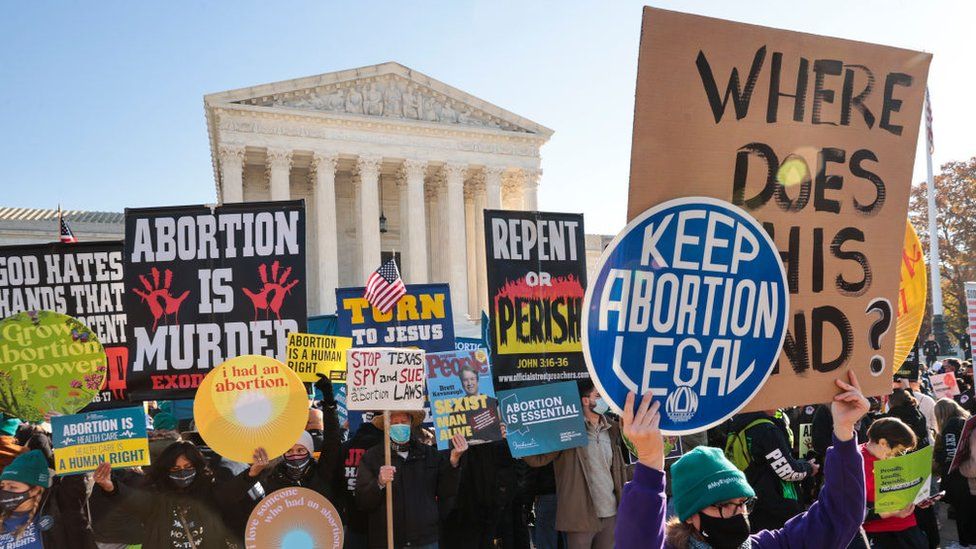ARTICLE AD BOX
By Paul Sargeant & Robin Levinson-King & Chloe Kim
BBC News
 Image source, Getty Images
Image source, Getty Images
The US Supreme Court could be about to open the door for individual states to ban or severely restrict the ability for pregnant women to get abortions.
In 1973, the court had ruled in Roe v Wade that pregnant people were entitled to an abortion during the first three months of their pregnancy, while allowing for legal restrictions and bans in the second and third trimester.
But a leaked draft of their forthcoming ruling suggests the court is poised to overturn that earlier ruling, effectively making it possible for states to ban abortions earlier than 12 weeks. The decision is expected sometime later this month.
If that happens, abortion would not automatically become illegal in the US - rather, it would allow individual states to decide if and how to allow abortions. Many states have passed "trigger laws" that come into effect upon Roe v Wade being overturned. Others have left old laws on the books that banned abortion prior to 1973 - if Roe v Wade is overturned, they could go back into force.
Over the past decade, several states have also tried to pass laws making abortion illegal, except in a few circumstances such as if the pregnant woman's life is at risk. Some of those laws were struck down by lower courts, as they appeared to violate Roe v Wade. If Roe v Wade is overturned, they will likely come back into force.
Recently, Texas and Oklahoma tried to bypass Roe v Wade entirely by going around the criminal justice system and allowing private citizens to sue people who help in getting abortions. In those states, abortion is currently illegal for most cases.
Who gets abortions in the US?
The Guttmacher Institute, which supports abortion rights, estimates that some 40 million women of child-bearing age will live in states where abortion will become more difficult to access.
About 630,000 abortions were performed in the US in 2019, according to the US Center for Disease Control (CDC), although Guttmacher's own research indicates it may be closer to 860,000.
The CDC says that the vast majority of abortions, 92.8%, are performed during the first trimester. Most people who get abortions are unmarried, although they may be living with a partner at the time. About one in 10 women who get an abortion are teenagers, with most being in their 20s. About 60% of people who get abortions have also given birth before, and nearly 60% had never had an abortion before.
What kind of restrictions will come into place?
If abortion access is left up to individual states, who can get an abortion, and how, will vary widely across the country. Some states have moved to increase abortion protections, enshrining the right to an abortion in state laws.
But about 26 states are making moves to limit access, according to Guttmacher. Some states intend to ban abortion from the moment of conception, while others are introducing bans at six or more weeks.
All states allow abortion to save the life of the mother, while some will also allow exceptions to their ban for cases of rape or incest.
Most states have said they will not prosecute women for trying to end their pregnancy, reserving criminal penalties for abortion providers and others who try and help people get abortions.
Here's a look at what could happen in certain states if Roe v Wade is overturned.
Skip What abortion restrictions are individual states expected to introduce?
What abortion restrictions are individual states expected to introduce?
From conception
-
Alabama Exceptions: to save the health or life of the mother or in cases where the child is unlikely to survive after birth

A law would make abortions illegal at any stage of pregnancy - except in cases where it is necessary “to prevent a serious health risk” to the mother or if there is a “lethal fetal anomaly”. There is no exception for sexual assault or incest.
The law was blocked by a federal judge but could be re-enacted. Under the law, a doctor accused of performing an abortion could face up to 99 years in prison.
- Number of women aged 14-44: 949,900
- Abortions per 1,000 women: 8.1
- Number of abortion clinics: 5
Updated: 15 June 2022
-
Arkansas Exceptions: to save the life of the mother

A trigger law passed in 2019 would go into effect, banning abortion at any stage of pregnancy. The only exception is if the pregnant person’s life is in danger.
Anyone who attempted to perform an abortion could be fined up to $100,000 and serve up to 10 years in prison.
- Number of women aged 14-44: 577,400
- Abortions per 1,000 women: 6.4
- Number of abortion clinics: 3
Updated: 15 June 2022
-
Idaho Exceptions: to save the life of the mother or in documented cases of rape or incest

A trigger law passed in 2022 would go into effect, banning abortion at any stage of pregnancy.
There is an exception to save the pregnant person’s life. Victims of rape or incest are also exempt if the crime was previously reported to law enforcement and a police report has been provided to the physician. Medical providers who violate this could face time in prison.
- Number of women aged 14-44: 328,900
- Abortions per 1,000 women: 5.4
- Number of abortion clinics: 3
Updated: 15 June 2022
-
Louisiana Exceptions: to save the life of the mother

A trigger law passed in 2006 would go into effect, banning abortion at any stage.
There is an exception if the pregnant person’s life is in danger. A pregnant person is shielded from criminal liability, but anyone who performs an abortion could be jailed and issued a fine of up to $100,000.
- Number of women aged 14-44: 936,100
- Abortions per 1,000 women: 10
- Number of abortion clinics: 4
Updated: 15 June 2022
-
Michigan Exceptions: to save the life or prevent severe physical harm to the mother

Abortion would remain legal until viability, which is around 24-28 weeks. After that, it would only be legal to save the life of the mother.
A pre-Roe ban from 1931 is still on the books, making abortions illegal except to save the mother’s life. There are no exceptions for rape or incest. A judge ordered a preliminary ban on enforcing the old law should Roe fall, but the decision could be challenged.
- Number of women aged 14-44: 1,874,300
- Abortions per 1,000 women: 13.9
- Number of abortion clinics: 21
Updated: 15 June
-
Oklahoma Exceptions: to save the life of the mother

A trigger law that passed in 2021 would go into effect, banning abortion at any stage of pregnancy. There are no exceptions for rape or incest. There is an exception to protect the life of the mother. Providing an abortion otherwise would be punishable with prison time.
In May, Oklahoma passed one of the most restrictive abortion laws in the country, banning abortion from the moment of fertilisation. That provision essentially bypassed Roe v Wade entirely, putting it up to private citizens, not the state, to enforce the law.
- Number of women aged 14-44: 768,800
- Abortions per 1,000 women: 6.2
- Number of abortion clinics: 4
Updated: 15 June 2022
-
Texas Exceptions: to save the life of the mother

A trigger law passed in 2021 would go into effect, banning abortion at any stage. There is an exception for medical emergencies to save the mother’s life. There are no exceptions for rape or incest. Anyone who performs abortions could face up to life in prison and fines, but patients themselves would be exempted from prosecution.
Last year, Texas effectively banned almost all abortions except in cases of “medical emergency”. The law, which made it illegal to obtain an abortion after about six weeks, bypassed Roe v Wade by giving private citizens the right to sue anyone who helps a woman have an abortion.
- Number of women aged 14-44: 5,885,900
- Abortions per 1,000 women: 9.5
- Number of abortion clinics: 21
Updated: 15 June 2022
-
Ohio Exceptions: to save the life of the mother

A bill banning abortion after six weeks, which was passed in 2019 but blocked by a judge, could go into effect if Roe falls.
The bill would make exceptions only to protect the life of the mother. Doctors who perform an abortion could face up to 25 years in prison and lose their medical licence.
- Number of women aged 14-44: 2,203,300
- Abortions per 1,000 women: 9.3
- Number of abortion clinics: 9
Updated: 15 June 2022
-
Kentucky Exceptions: to save the life or prevent severe physical harm to the mother

A trigger law passed in 2019 could go into effect, banning abortion at any stage.
There would be exceptions to prevent the mother's death or the "permanent impairment of a life-sustaining organ". There are no exceptions for rape or incest. Performing an abortion would be considered a felony - punishable by time in prison.
- Number of women aged 14-44: 848,500
- Abortions per 1,000 women: 5.6
- Number of abortion clinics: 1
Updated: 15 June 2022
-
Mississippi Exceptions: to save the life of the mother or in cases of rape or incest

A trigger law passed in 2007 would go into effect, banning abortion at any stage of pregnancy.
There are exceptions for rape and to save the mother’s life. Medical providers who violate this could face imprisonment for up to 10 years.
- Number of women aged 14-44: 591,700
- Abortions per 1,000 women: 8.3
- Number of abortion clinics: 1
Updated: 15 June 2022
-
Missouri Exceptions: to save the life or prevent severe physical harm to the mother

A trigger law passed in 2019 would go into effect, making abortions illegal at any stage of pregnancy.
There is an exception for medical emergencies to save the mother’s life or to prevent “irreversible physical impairment of a major bodily function”. There are no exceptions for rape or incest. Doctors who perform an abortion could be charged with a felony and have their medical licence revoked.
- Number of women aged 14-44: 1,171,800
- Abortions per 1,000 women: 8.3
- Number of abortion clinics: 3
Updated: 15 June 2022
-
North Dakota Exceptions: to save the life of the mother or in cases of rape or incest

A trigger law passed in 2007 would go into effect, banning abortion at any stage.
There are exceptions for saving the life of the mother, rape or incest. Violators could face fines and imprisonment and it would make abortions a felony.
- Number of women aged 14-44: 146,200
- Abortions per 1,000 women: 6.6
- Number of abortion clinics: 1
Updated: 15 June 2022
-
South Dakota Exceptions: to save the life of the mother

A trigger law passed in 2005 would go into effect, banning abortion at any stage of pregnancy.
There are no exceptions for rape or incest. Performing an abortion on someone, unless to save a mother’s life, would be classified as a felony.
- Number of women aged 14-44: 158,900
- Abortions per 1,000 women: 4.7
- Number of abortion clinics: 1
Updated: 15 June 2022
-
Tennessee Exceptions: to save the life of the mother

A trigger law passed in 2019 would ban abortion at any stage of pregnancy.
There is an exception to save a mother’s life, but there are no exceptions for rape or incest. Providing or attempting to provide an abortion would be a felony.
- Number of women aged 14-44: 1,312,500
- Abortions per 1,000 women: 8.4
- Number of abortion clinics: 8
Updated: 15 June 2022
-
Utah Exceptions: to save the life of the mother or in cases of rape or incest

A trigger law passed in 2020 would be enacted, banning abortion at any stage of pregnancy. There are exceptions to save the mother’s life and for rape or incest, if it was reported to law enforcement.
There are also exceptions if the fetus has a lethal defect or a “severe brain abnormality”, not including Down’s syndrome, cerebral palsy, spina bifida and other conditions that do not result in a vegetative state. Anyone who performs an abortion could be charged with a felony.
- Number of women aged 14-44: 675,100
- Abortions per 1,000 women: 4.5
- Number of abortion clinics: 3
Updated: 15 June 2022
-
Wisconsin Exceptions: to save the life of the mother

A 1849 law banning most abortions could come into effect again.
There are no exceptions for rape or incest. There is an exception for saving the life of the mother.
The law would make it a felony to provide an abortion to someone outside those terms. The state’s Democratic attorney general questions the enforceability of the 173-year-old law.
- Number of women aged 14-44: 1,083,800
- Abortions per 1,000 women: 7
- Number of abortion clinics: 3
Updated: 15 June 2022
-
Wyoming Exceptions: to save the life or prevent severe physical harm to the mother, or in cases of rape or incest

A trigger law passed in 2022 goes into effect, banning abortion at any stage of pregnancy.
There are exceptions for life endangerment, severe physical health conditions, sexual assault and incest. Anyone who performs an abortion could be charged with a felony.
- Number of women aged 14-44: 107,700
- Abortions per 1,000 women: 6.7
- Number of abortion clinics: 2
Updated: 15 June 2022
From 6 weeks
-
Georgia Exceptions: to save the life or prevent severe physical harm to the mother, or cases of rape or incest before 20 weeks

A bill banning abortions after around six weeks was passed in 2019, but then blocked by a federal judge. It could be re-enacted if Roe falls.
There are exceptions for medical emergencies, cases of rape or incest that have been documented through an official police report and are fewer than 20 weeks along.
- Number of women aged 14-44: 2,147,400
- Abortions per 1,000 women: 15.2
- Number of abortion clinics: 15
Updated: 15 June 2022
-
Iowa Exceptions: to save the life of the mother, cases of rape or incest, or if the child is unlikely to survive after birth

In 2018, Iowa passed a bill banning abortion after six weeks, except in cases of rape, incest, foetal anomaly, or in a medical emergency risking death or serious injury.
But a judge issued an injunction on the law. In June, the state’s highest court ruled the state constitution did not guarantee a right to abortion, setting the state for the injunction to be lifted if Roe is overturned.
- Number of women aged 14-44: 592,300
- Abortions per 1,000 women: 6.2
- Number of abortion clinics: 8
Updated: 15 June 2022
-
South Carolina Exceptions: to save the life of the mother, rape or incest, or if the child is unlikely to survive after birth

Abortion could be banned after six weeks if a law passed in 2021 - but blocked by a judge - is allowed to go into effect.
There are exceptions to save the mother’s life, and for rape or incest if the pregnancy is before 20 weeks. It also allows for abortion if there is a foetal anomly that would be “incompatible with sustaining life after birth”.
- Number of women aged 14-44: 965,700
- Abortions per 1,000 women: 11.8
- Number of abortion clinics: 4
Updated: 15 June 2022
From 13 weeks
-
Arizona Exceptions: to save the life or prevent severe physical harm to the mother

In March, Arizona passed a law banning abortion at 15 weeks, except in cases of medical emergency. There are no exceptions for rape or incest.
It could go into force at the end of September. A doctor found to have performed an illegal abortion after 15 weeks would face a felony charge, fines and up to five years in prison. They could also have their medical licence revoked.
The state also has a pre-Roe ban that would ban all abortions, but it’s unclear which law the state would enforce.
- Number of women aged 14-44: 1,345,800
- Abortions per 1,000 women: 9.8
- Number of abortion clinics: 8
Updated: 15 June 2022
-
North Carolina Exceptions: to save the life or prevent severe physical harm to the mother

A 1973 law banning abortions after 20 weeks of pregnancy is still on the books.
In 2015 it was amended to narrow the exceptions, allowing abortions only in cases where the life of the mother was threatened, or she risked serious physical bodily harm. Doctors who perform abortions could be charged with a felony.
But a court ruled that law was unenforceable because of Roe v Wade. It could come back into force.
- Number of women aged 14-44: 2,016,700
- Abortions per 1,000 women: 12.4
- Number of abortion clinics: 14
Updated: 15 June 2022
-
West Virginia Exceptions: to save the life or prevent severe physical harm to the mother

The state could enforce a 19th century law prohibiting abortion.
The pre-Roe law criminalises abortion as a felony.
- Number of women aged 14-44: 322,300
- Abortions per 1,000 women: 7.4
- Number of abortion clinics: 1
Updated: 15 June 2022
End of What abortion restrictions are individual states expected to introduce?
State-specific statistics in the table above are from 2017, the most recent date for which data is available from Guttmacher Institute.
The map at the top of the page showing states expected to be among the first to restrict abortion includes only those in which laws will either automatically come into force or which require no more than a signature from the state governor or attorney general certifying that the Supreme Court has overturned Roe v Wade. States with abortion laws which have been blocked by the courts and therefore require legal action to appeal or dismiss them are not shown, these include Georgia, Michigan, Ohio, South Carolina and West Virginia.
The Guttmacher Institute's 2014 Abortion Patient Survey still provides the most recent national overview on the social and economic background of those having abortions in the US. However, changes in the US economy and access to abortion over the last eight years means the picture could have changed.

 2 years ago
19
2 years ago
19








 English (US)
English (US)